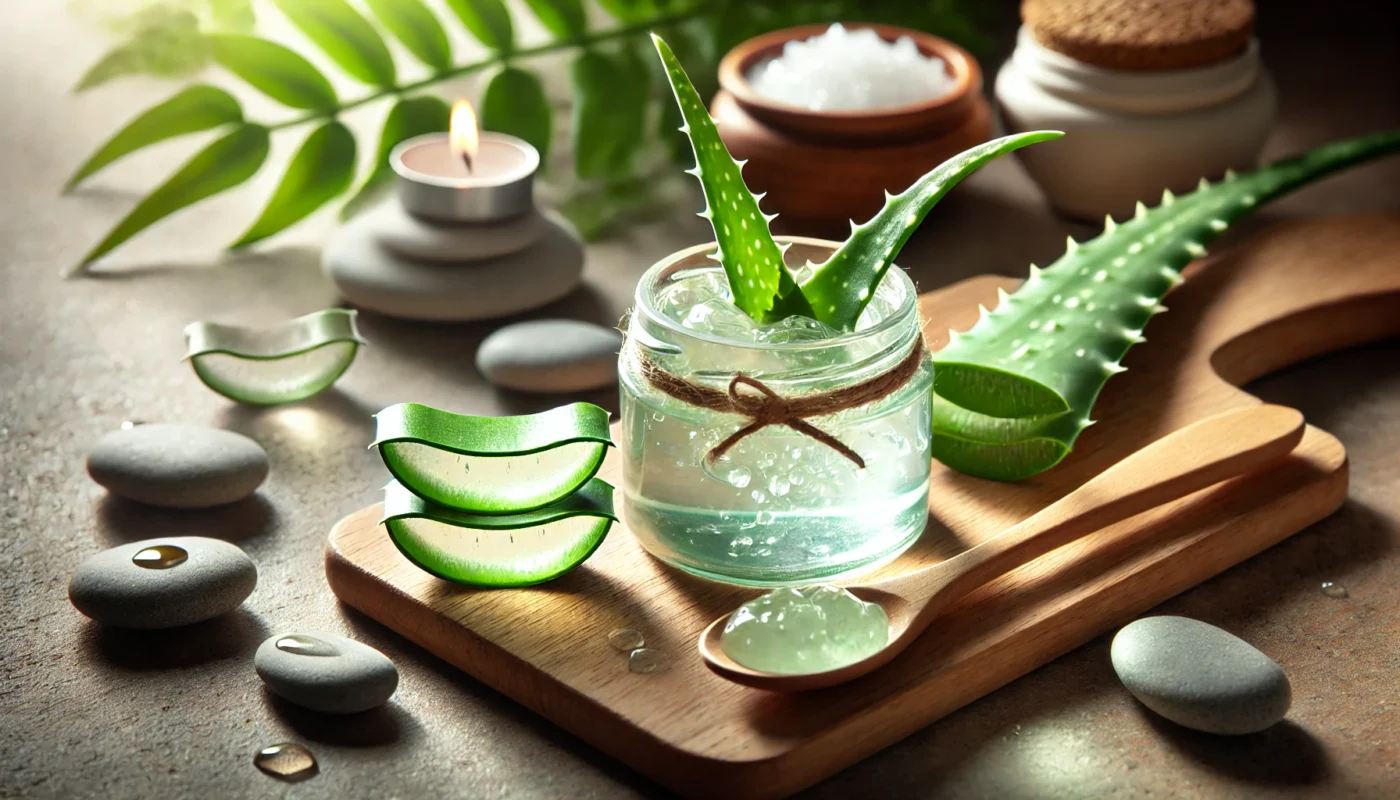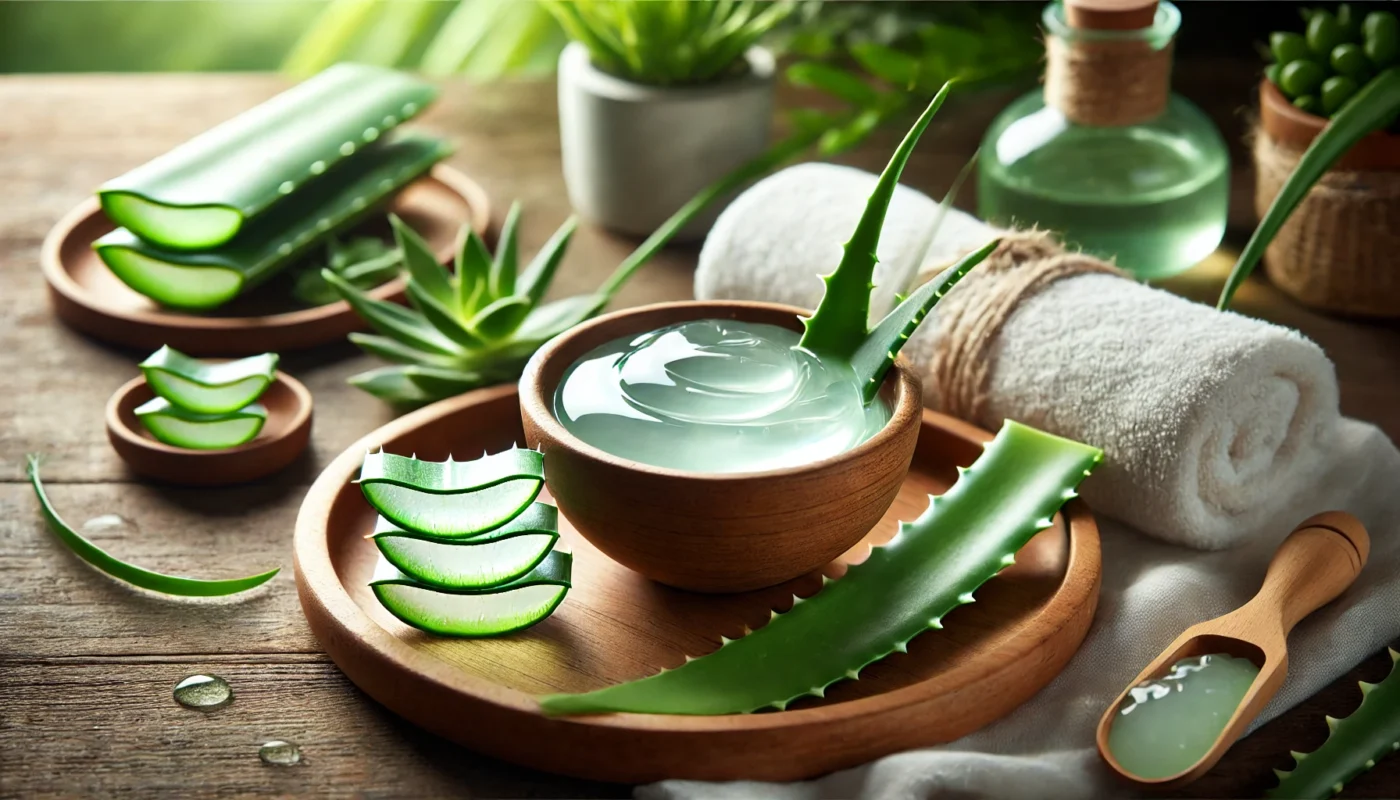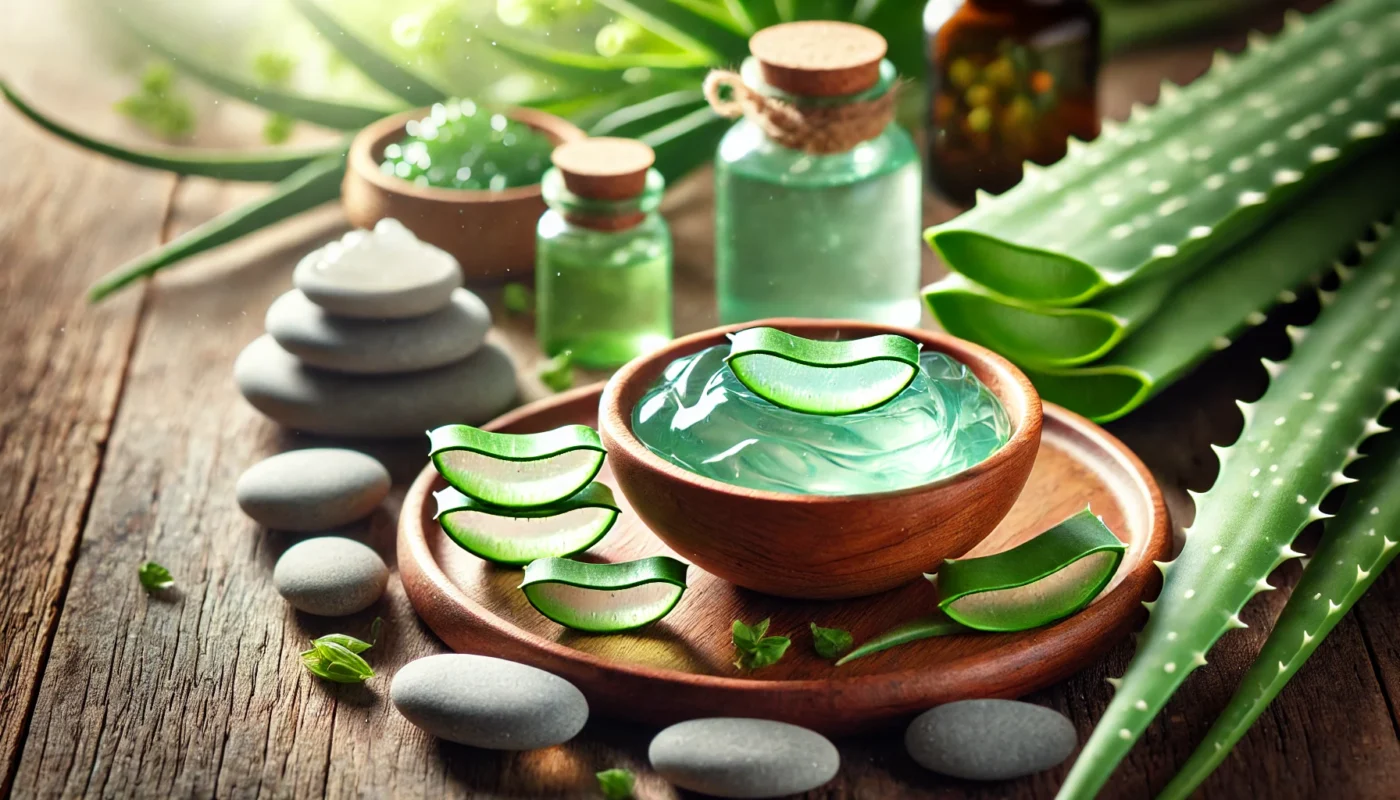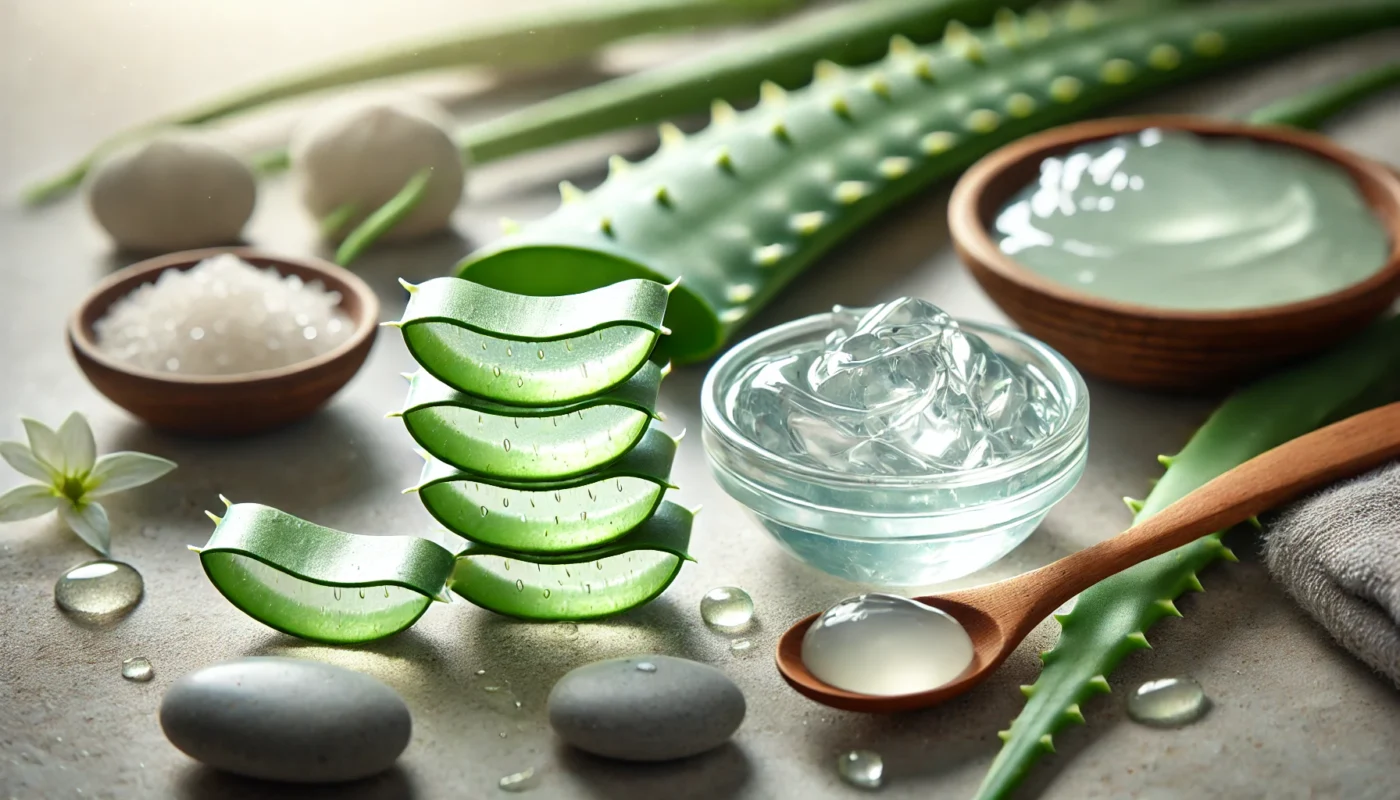Aloe vera has long been hailed as a miraculous plant, renowned for its impressive healing properties, particularly for the skin. Its use in traditional medicine spans thousands of years, with cultures across the globe praising its ability to soothe, heal, and rejuvenate. But what is it about this succulent plant that makes it such a potent ally for skin healing? In this article, we delve into the myriad benefits of aloe vera for skin healing, backed by scientific research, and provide practical advice for incorporating this botanical wonder into your skincare routine.
You may also like: Home Remedies: Fight Cut Infections Naturally
The Science Behind Aloe Vera’s Healing Properties
Aloe vera contains a plethora of bioactive compounds that contribute to its healing prowess. The gel extracted from its leaves is rich in vitamins, enzymes, minerals, amino acids, and antioxidants. These components work synergistically to promote skin health and accelerate the healing process.
Key Components of Aloe Vera Gel
Vitamins
Aloe vera is a powerhouse of essential vitamins such as A, C, and E. Vitamin A plays a crucial role in skin cell production and turnover, helping to maintain a youthful appearance. Vitamin C is renowned for its ability to boost collagen production, enhancing skin elasticity. Vitamin E acts as a powerful antioxidant, protecting the skin from environmental stressors and promoting overall skin health. Together, these vitamins form a defense barrier against free radicals, reducing oxidative stress and promoting rapid skin repair.
Enzymes
The enzymes present in aloe vera, such as bradykinase, are instrumental in reducing inflammation. Bradykinase works by breaking down bradykinin, a peptide that causes pain and swelling. Additionally, enzymes like amylase and lipase help in the breakdown of sugars and fats, respectively, ensuring that nutrients are efficiently absorbed into the skin. This enzymatic activity not only soothes irritated skin but also promotes a smoother texture and appearance.
Minerals
Aloe vera is abundant in essential minerals, including calcium, magnesium, and zinc. Calcium supports cellular adhesion and tissue integrity, while magnesium is vital for DNA repair and energy production in skin cells. Zinc plays a pivotal role in wound healing and is known for its anti-inflammatory properties, making it beneficial for acne-prone skin. These minerals work collectively to maintain skin barrier function and promote a healthy complexion.
Amino Acids
Aloe vera provides 20 of the 22 human-required amino acids, including seven of the eight essential ones. These amino acids are fundamental in protein synthesis, necessary for repairing and regenerating skin tissues. Glycine and proline, two key amino acids found in aloe, aid in collagen formation, while serine and threonine promote skin hydration and elasticity. The presence of these amino acids ensures that the skin remains resilient and youthful.
Polysaccharides
Polysaccharides, such as acemannan, found in aloe vera gel, offer a multitude of benefits. They form a protective barrier on the skin, locking in moisture and preventing dehydration. Acemannan also has potent anti-inflammatory properties, reducing redness and irritation. Furthermore, these polysaccharides stimulate the immune system, enhancing the skin’s ability to combat infections and promote rapid healing.

Aloe Vera for Cuts and Wounds
Aloe vera is particularly effective for minor cuts and abrasions. Its antimicrobial properties help reduce the risk of infection, while its anti-inflammatory effects soothe the skin and minimize swelling. Moreover, aloe vera stimulates fibroblast activity, which plays a pivotal role in collagen synthesis, thereby promoting faster wound closure.
Is Aloe Good for Cuts?
Antimicrobial Properties
Aloe vera’s gel contains compounds like saponins that exhibit antimicrobial activity, which is essential for preventing infections in cuts and wounds. By inhibiting the growth of bacteria and fungi, aloe vera reduces the likelihood of complications during the healing process. This natural defense mechanism is particularly beneficial for minor cuts, where the risk of infection is heightened.
Anti-inflammatory Effects
The anti-inflammatory properties of aloe vera are primarily attributed to its enzyme content, which helps reduce swelling and redness. This soothing effect not only provides immediate relief from pain but also accelerates the healing process. By calming the inflammatory response, aloe vera ensures a smoother and less painful recovery.
Collagen Synthesis
Aloe vera enhances fibroblast activity, which is essential for collagen production. Collagen is a structural protein that plays a critical role in wound healing by forming a new tissue matrix. By promoting collagen synthesis, aloe vera aids in faster wound closure and minimizes scarring, ensuring that the skin heals seamlessly.
Aloe Vera on Open Wounds
Protective Barrier
For open wounds, aloe vera acts as a natural barrier, keeping the area hydrated and protected from environmental contaminants. Its gel-like consistency forms a protective layer over the wound, preventing the entry of dirt and bacteria. This barrier not only ensures cleanliness but also facilitates a conducive environment for healing.
Hydration and Moisture Retention
Aloe vera’s high water content ensures that open wounds remain hydrated, which is crucial for tissue regeneration. Moisture retention prevents the wound from drying out and cracking, which can delay healing. By maintaining optimal hydration levels, aloe vera supports rapid tissue repair and minimizes discomfort.
Caution for Severe Wounds
While aloe vera is beneficial for superficial injuries, it is important to exercise caution with deep or severe wounds. In such cases, the plant’s gel may not provide sufficient protection or healing. Consulting a healthcare professional for proper wound management is essential to prevent complications and ensure effective treatment.
Practical Application Tips
Clean the Area
Before applying aloe vera, ensure the wound is clean to prevent infection. Gently wash the area with mild soap and water, patting it dry with a clean cloth. This step removes dirt and debris, creating a sterile environment for aloe vera application.
Apply Fresh Gel
Extract fresh gel from an aloe vera leaf and apply it directly to the wound. The fresh gel contains the highest concentration of active compounds, maximizing its healing potential. If fresh gel is unavailable, opt for a high-quality, preservative-free aloe vera gel product to ensure purity and efficacy.
Cover if Necessary
For cuts that require protection, cover with a sterile bandage after applying aloe to enhance healing. The bandage not only keeps the area clean but also helps the aloe vera gel to remain in place, allowing continuous exposure to its healing properties. Change the bandage regularly to maintain hygiene and promote healing.
Reapply
For optimal results, reapply aloe vera gel two to three times daily. Regular application ensures that the wound remains hydrated and protected throughout the healing process. Consistent use of aloe vera promotes faster recovery and reduces the risk of scarring.

Aloe Vera and Skincare
Aloe vera’s benefits extend beyond healing cuts and wounds; it’s also a powerful skincare ally.
Moisturization and Hydration
Suitable for All Skin Types
Aloe vera is an excellent moisturizer, suitable for all skin types. Its light, non-greasy texture makes it ideal for oily and acne-prone skin, while its hydrating properties benefit dry and sensitive skin. By balancing moisture levels, aloe vera ensures that the skin remains supple and radiant.
Polysaccharides and Moisture Retention
The polysaccharides in aloe vera gel lock in moisture, creating a protective barrier that prevents water loss. This barrier function is crucial for maintaining skin hydration and preventing dryness. By enhancing moisture retention, aloe vera promotes a soft and smooth complexion.
Soothing and Calming Effects
Aloe vera’s soothing properties make it an effective remedy for irritated or inflamed skin. Its cooling sensation provides instant relief from discomfort, reducing redness and sensitivity. By calming the skin, aloe vera ensures a clear and even-toned appearance.
Soothing Sunburns and Irritations
Cooling Sensation
The cooling properties of aloe vera gel provide instant relief for sunburned skin. Its gel-like consistency absorbs heat and soothes the skin, alleviating discomfort. This cooling effect is particularly beneficial after prolonged sun exposure, offering a natural remedy for sunburn.
Anti-inflammatory and Antioxidant Benefits
Aloe vera’s anti-inflammatory effects reduce redness and swelling, while antioxidants assist in repairing UV-induced damage. By neutralizing free radicals, aloe vera protects the skin from further harm and accelerates the healing process. These combined benefits make aloe vera an essential component of post-sun skincare.
Enhancing Skin Recovery
Regular application of aloe vera on sunburned skin promotes rapid recovery and minimizes peeling. Its hydrating properties ensure that the skin remains moisturized, preventing dryness and flakiness. By supporting the skin’s natural healing mechanisms, aloe vera restores its health and vitality.
Anti-Aging Effects
Boosting Collagen Production
Regular use of aloe vera can help reduce the appearance of fine lines and wrinkles. Its ability to boost collagen production and improve skin elasticity makes it a valuable component of anti-aging skincare routines. By enhancing the skin’s structural integrity, aloe vera promotes a youthful and resilient complexion.
Improving Skin Elasticity
Aloe vera’s moisturizing properties enhance skin elasticity, reducing sagging and promoting firmness. Its amino acid content supports the skin’s natural repair processes, maintaining its elasticity and suppleness. This elasticity-boosting effect helps to preserve the skin’s youthful appearance over time.
Reducing Fine Lines and Wrinkles
The antioxidant properties of aloe vera protect the skin from oxidative stress, a key contributor to aging. By neutralizing free radicals, aloe vera minimizes the formation of fine lines and wrinkles, preserving the skin’s smoothness. Its anti-aging benefits make aloe vera a staple in any skincare regimen focused on maintaining youthful skin.
Acne Treatment
Antibacterial Properties
Aloe vera’s antibacterial properties help combat acne-causing bacteria, while its anti-inflammatory effects reduce redness and swelling associated with breakouts. By targeting the root cause of acne, aloe vera effectively prevents new blemishes from forming. Its natural antibacterial action makes it a gentle alternative to harsh acne treatments.
Astringent Effects
Aloe vera’s astringent properties help tighten pores, reducing the likelihood of future breakouts. By minimizing pore size, aloe vera limits the accumulation of dirt and oil, which can lead to acne. Its astringent benefits ensure a clearer and more refined complexion.
Healing and Soothing Breakouts
Aloe vera promotes the healing of existing breakouts by reducing inflammation and accelerating skin repair. Its soothing properties alleviate irritation and discomfort, ensuring a smoother recovery. By addressing both active acne and residual marks, aloe vera supports a blemish-free complexion.

Choosing and Using Aloe Vera Products
When selecting aloe vera products, prioritize those with high concentrations of pure aloe vera gel and minimal additives. Look for products labeled as 99% or 100% pure aloe vera gel, and avoid those with alcohol or artificial fragrances, which can irritate the skin.
DIY Aloe Vera Remedies
Growing Your Own Aloe Vera
For those who prefer a more natural approach, growing your own aloe vera plant is an excellent option. Aloe vera is a hardy plant that thrives in various conditions, making it easy to cultivate at home. By growing your own plant, you have a readily available source of fresh gel for skincare use.
Harvesting and Using Fresh Gel
Simply harvest a leaf, slice it open, and scoop out the gel for immediate use. This ensures the gel is fresh and free from preservatives, maximizing its potency. Fresh aloe vera gel can be applied directly to the skin or incorporated into homemade skincare recipes for customized treatments.
Creating Natural Skincare Products
DIY enthusiasts can combine fresh aloe vera gel with other natural ingredients to create personalized skincare products. Mix aloe vera with essential oils for a nourishing serum or combine it with honey for a hydrating face mask. These homemade remedies allow for tailored skincare solutions that address specific concerns.
Incorporating Aloe Vera into Your Routine
Standalone Moisturizer
Aloe vera can be seamlessly integrated into your daily skincare regimen as a standalone moisturizer. Its lightweight texture makes it suitable for morning and evening use, providing hydration without clogging pores. Regular use ensures that the skin remains balanced and nourished.
Customized Serums
Mix aloe vera with essential oils for a personalized serum that addresses specific skincare needs. Essential oils like lavender or tea tree can enhance aloe vera’s soothing and antibacterial properties, creating a targeted treatment for various skin concerns. This customization allows for a versatile and effective skincare routine.
Soothing Face Masks
Combine aloe vera with other natural ingredients like honey or cucumber for a soothing face mask. These masks provide an intensive treatment that hydrates and revitalizes the skin, offering a spa-like experience at home. By incorporating aloe vera into face masks, you can achieve a radiant and refreshed complexion.
Conclusion
Aloe vera is a versatile and potent natural remedy for skin healing and care. Its wide array of beneficial compounds makes it an invaluable addition to any skincare routine, offering relief from cuts, wounds, sunburns, and more. By understanding the science behind aloe vera’s healing properties and incorporating it into your daily regimen, you can harness its full potential and enjoy healthier, more radiant skin.
In the ever-expanding world of skincare, aloe vera stands out as a time-tested, scientifically-backed ally. Whether you’re dealing with a minor cut or seeking to enhance your skin’s overall health, aloe vera offers a natural, effective solution. Embracing aloe vera as part of your skincare journey not only supports optimal skin health but also connects you with a tradition of healing that spans centuries.
Further Reading:
Wound Healing: Aloe Vera as a Natural Bandage?
aloe vera, skincare, anti-aging, skin elasticity, fine lines, wrinkles, acne treatment, antibacterial properties, astringent effects, DIY remedies, natural skincare, moisturizing, healing, soothing, face masks, essential oils
Important Note: The information contained in this article is for general informational purposes only, and should not be construed as health or medical advice, nor is it intended to diagnose, prevent, treat, or cure any disease or health condition. Before embarking on any diet, fitness regimen, or program of nutritional supplementation, it is advisable to consult your healthcare professional in order to determine its safety and probable efficacy in terms of your individual state of health.
Regarding Nutritional Supplements Or Other Non-Prescription Health Products: If any nutritional supplements or other non-prescription health products are mentioned in the foregoing article, any claims or statements made about them have not been evaluated by the U.S. Food and Drug Administration, and such nutritional supplements or other health products are not intended to diagnose, treat, cure, or prevent any disease.

